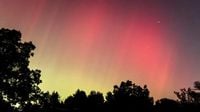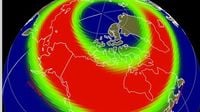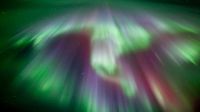Skygazers across the northern United States are gearing up for a spectacular display of the northern lights, or aurora borealis, this week, thanks to a series of solar eruptions that have sent charged particles hurtling towards Earth. The National Oceanic and Atmospheric Administration (NOAA) has predicted that the stunning light show will be visible on the nights of Tuesday, April 15, 2025, and Wednesday, April 16, 2025, providing a rare opportunity for residents in several states to witness this celestial phenomenon.
The auroras are caused when electrically charged particles from the sun collide with gases in Earth’s atmosphere, particularly near the magnetic poles. This interaction creates vibrant ribbons of light that can be seen dancing across the night sky. According to the NOAA Space Weather Prediction Center, the expected geomagnetic storm is rated as G3, indicating strong storm conditions that could allow the northern lights to be visible much farther south than usual, potentially reaching states like Illinois and Oregon.
However, the best viewing spots will likely be in northern states such as North Dakota, Montana, Minnesota, and Wisconsin, where the auroras are expected to be most vibrant. Other states that may catch a glimpse include Michigan, Maine, New York, and even parts of Pennsylvania. NOAA has provided a list of states where the aurora borealis might be visible, emphasizing that residents should look towards the northern horizon for the best chance of seeing the lights.
Mark Pellerito, a meteorologist with the National Weather Service in Binghamton, New York, shared some insights on the viewing conditions in that area. He cautioned that the chances of seeing the northern lights in Binghamton are “unfortunately kind of bleak,” due to an expected 80-90% cloud cover on Tuesday evening. While there may be some breaks in the clouds, the likelihood of a clear view remains slim. Pellerito noted that residents might have a better chance of seeing the lights during the pre-dawn hours on Thursday morning, April 17, when cloud coverage is predicted to diminish.
For those in the Midwest, AccuWeather suggests that the weather may be more favorable for viewing the auroras on Tuesday night, although cloud cover is expected to increase by Wednesday night. Areas in the northern Plains are anticipated to have clearer skies, making them prime locations for aurora chasers. In contrast, the Northeast, including regions like Utica and the Mohawk Valley, may face cloudy conditions and even wintry weather, complicating efforts to catch a glimpse of the lights.
As for the timing, the northern lights are generally most visible between 10 p.m. and 2 a.m. local time. Predicting the exact timing of the auroras can be challenging, as it depends on solar activity and local weather conditions. The NOAA recommends checking their real-time aurora forecast for updates on the best viewing times.
The phenomenon of the northern lights is not only a beautiful spectacle but also a fascinating scientific occurrence. The aurora borealis is a result of solar winds interacting with the Earth’s magnetic field, which usually protects the planet from such solar activity. However, during strong solar storms, these winds can bypass the magnetic shield, allowing charged particles to enter the atmosphere and create the stunning light displays.
During the current geomagnetic storm, which is expected to last through April 17, 2025, heightened geomagnetic activity is predicted, giving skywatchers an extended window to catch the northern lights. The auroras can last anywhere from a few minutes to several hours, depending on the strength of the solar storm and local atmospheric conditions.
For those eager to capture the beauty of the auroras, long-exposure photography can be a useful technique, allowing individuals to photograph the lights even if they are not visible to the naked eye. However, the best viewing experience is often found in remote areas away from city lights, where light pollution is minimal.
Despite the excitement surrounding this week’s aurora forecasts, it’s important for enthusiasts to remain realistic about their viewing chances. For many in the southern regions, including Arizona, the northern lights will not be visible due to the state's geographical location. While rare occurrences of faint displays have been reported in northern Arizona during extreme geomagnetic storms, this week’s activity is not expected to reach that far south.
As the solar eruptions continue to unfold, skywatchers are encouraged to stay informed through space weather alerts and forecasts. Apps like "My Aurora Forecast & Alerts" can help keep enthusiasts updated on the latest conditions and viewing opportunities. With the right conditions, this week could offer a memorable experience for those lucky enough to witness the northern lights.
In summary, the upcoming nights promise to be a thrilling time for skywatchers across the northern United States, with the potential for breathtaking displays of the aurora borealis. While some regions may face challenges due to weather conditions, the excitement of the celestial show continues to draw attention from both seasoned aurora chasers and casual observers alike.







